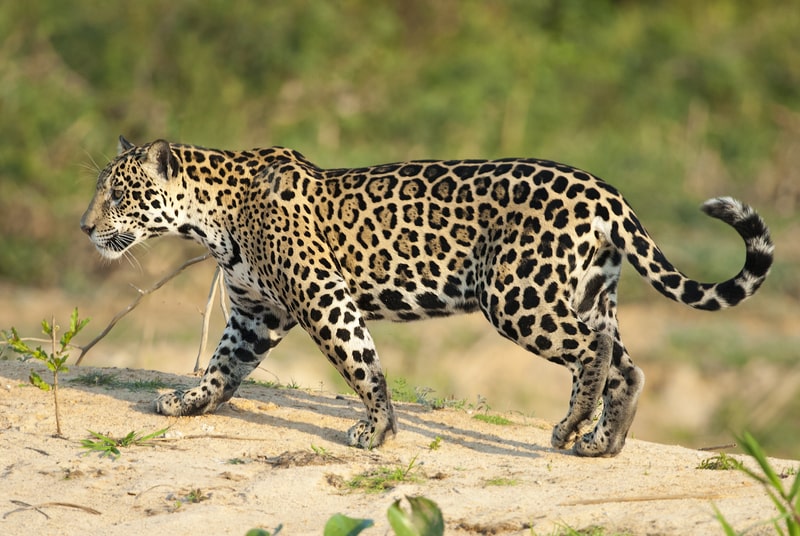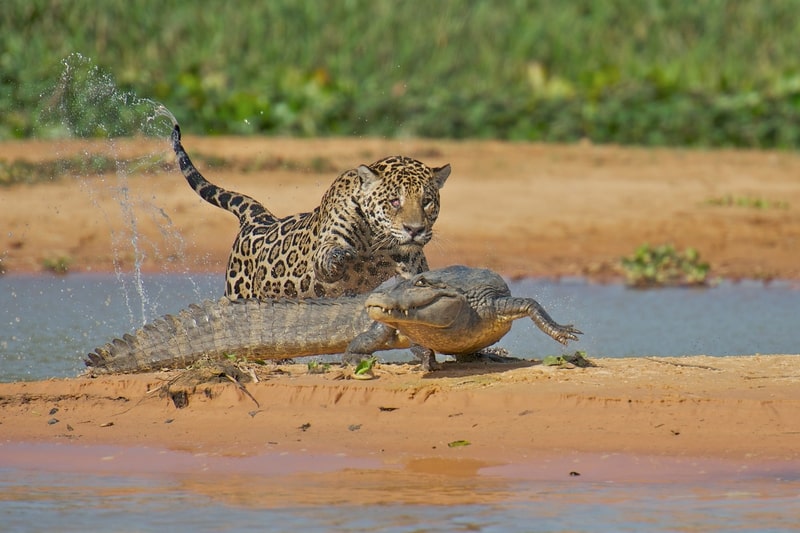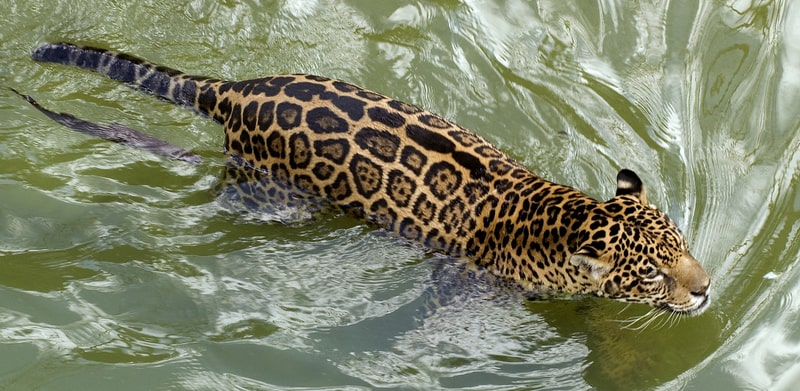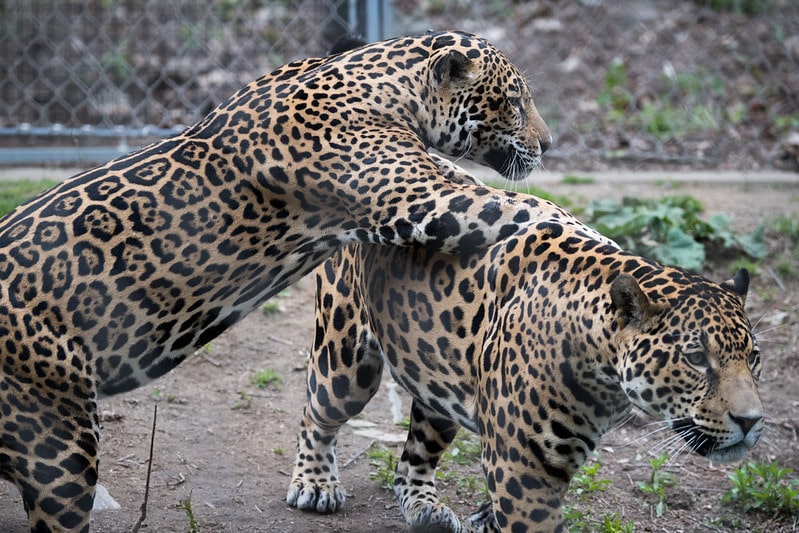Last updated on January 18th, 2023
The jaguar, like most of the big cats, is a fascinating animal. They are powerful, efficient and sleek. They jump on their prey seemingly out of nowhere. They can kill with a single bite. They have been associated with strength and power for centuries in the lands they live in. They were even chosen as the mascot of a major sports franchise! Here are 35 interesting facts about jaguars, one of the planet’s most beautiful and elusive creatures.
Facts about jaguars
1. The word “jaguar” comes from the Tupi-Guarani word ‘yaguara’ which means ‘wild beast that overcomes its prey at a bound’. This scientific name of the jaguar is Panthera onca.
2. Did you know that jaguars, lions, tigers, and leopards are the only big cats that can roar but they can’t purr? Cougars and smaller cats can purr, but they can’t roar.
3. A jaguar’s spots are highly individual. Each animal has a different pattern of spots that is as unique as a fingerprint. These markings are used by researchers to identify particular animals.
4. Although described as nocturnal, jaguar is more specifically crepuscular (peak activity around dawn and dusk).
5. Jaguars are considered big cats. The only bigger cats in the world are tigers and lions. They are the largest and the only species of big cat in the Americas.
6. The jaguar is the apex predator of its jungle habitat. It has no natural predators other than people. It is the true king of the Amazonian jungle. The natives regard it as such. However they don’t fear it. Though the Spanish Conquistadors were deathly afraid of the beast from the trees.
7. There is only one species or type of jaguar.

8. The jaguar’s bite force (1,500 psi) is measured as the most powerful of all the big cats. Bite force of other cats: tiger (1,050 psi), lion (650 psi), cheetah (500 psi), leopard (300 psi). The jaw muscles of a jaguar are stronger (relative to weight) than other cats and their arrangement also helps the animal deliver the impact to kill its prey.
9. The jaguar’s bite is incredibly powerful. It can even crack open the shells of the big turtles and crocodilians that are found in the Amazon rainforest. It can easily crack through any kind of bone or bony substance. This force is delivered by a powerful jaw and sharp pointed canines. No animal stands much of a chance against its deadly bite.
10. Jaguars are also the largest of South America’s cats. Other jungle cats include the ocelot.
11. Jaguars not only do not hate water, they actually enjoy it. Jaguars are often seen playing in water. The jaguar is quite the capable swimmer. This provides them a significant advantage when hunting prey like small crocodiles and other river animals. Swimming like this is quite rare among cats, especially house-cats, as some may know. But jaguars do it with ease and grace. This is true even when carrying large prey. They are strong powerful swimmers.

12. Jaguars have a highly diverse diet. They prey on more than 85 known species. This includes animals like turtles, cattle, deer and tapirs among others. They prefer mammals, but will eat reptiles and fish if necessary. Living near water, they can take down crocodilians easily. They sometimes dip their tails in water to attract fish. Jaguars will sometime attack cattle and other livestock. Especially if their preferred foods are unavailable due to deforestation and land use changes. This is a main source of conflict between humans and jaguars.
13. The female offspring may inherit their mother’s established territory when they come of age. This is usually around 2 years of age. Males seek out their own territory when they are about two years old. Jaguars mark out their territories with urine or claw marks. Sometimes the territories of females overlap. Males usually have distinct territories from each other. A male’s territory can overlap with those of females.
14. Jaguars are about as long (1.85 m), excluding the tail, as many people are tall. The shoulder height is about 75 cm. Their tails are relatively short for a large cat.
15. Jaguars rely on their camouflage fur to stalk and ambush hunt their prey. They kill with a single pounce and inflict a lethal bite. This is in contrast with other big cats which are famous for chasing down their prey. Jaguars who live in deep forests have darker fur than those that live in more grassy areas. This makes it much easier to blend into the dark forest canopy before pouncing on their stalked prey. In addition to being king of the rainforest, they are also its ninjas.
16. Most jaguars usually have a yellowish colored fur while in some jaguars it can also be black and white.
17. Of all big cats, the jaguar is least likely to kill and eat humans unless wounded or cornered.
18. Leopards look similar to jaguars and they are often confused for each other. They are completely separate species though. Here’s how to tell them apart. The rosettes (round spots) on a jaguar’s coat have a small dark spot in the middle. This is something a leopard lacks. The jaguar’s rosettes are also darker and thicker than a leopard’s.

19. A jaguar is also larger and more muscular than a leopard. A black panther is really just a jaguar with darkened fur, not a separate species as is sometimes believed.
20. Jaguars are believed to maintain the natural balance in the jungle ecosystem. Scientists call them a keystone species. The jaguars eat mostly herbivores like tapirs and cattle. This helps keep the herbivore population from growing too large. If that happened, too much of the plant life could be consumed, throwing the delicate jungle ecosystem out of balance.
21. Jaguars have an unusual way of killing prey for large cats. They bite their prey directly through the back of the skull with their powerful jaws. This inflicts a fatal injury on the brain. Most other big cats go for the throat and strangulate their prey. For smaller animals a hard swipe of the paw is enough to kill. They then drag their prey to a safe isolated place to eat. Jaguars are strong enough to climb trees with the animals they’ve killed.
22. Jaguars are casual about when they will mate. There is no particular breeding or mating season. Any time of year will do.
23. Jaguar cubs are born with their eyelids sealed shut. They have blue eyes at birth. They only start to see after about two weeks. The cubs are then weaned at about 3 months. They start to go out on hunts with the mother at about six months. Before that, the mother provides them with meat to eat. The father is not involved in raising the cubs. The males only hang around the females for a brief time after mating.
24. Jaguars can live up to 16 years in the wild. They have been known to live up to 23 years in captivity.
25. Jaguars can hunt in either night or day. Though researchers suggest they prefer night for hunting. Which one they choose depends on when their main prey is awake.
26. Did you know that jaguars have better night vision as compared to their day vision?
27. Once killed, jaguars start eating their prey at the chest. They eat the heart and lungs first. These are most nutritious parts for them. They then go for the shoulders. This differs from most large cats who start their meal at the neck.

28. Jaguars are mostly solitary animals. On occasion though two males will fight. Mostly jaguars like avoiding each other. Fights between males can occur but are rare. If population density is too high, sometime jaguars will socialize with each other. They will go fishing, swim and play with each other.
29. Jaguars use their roars to communicate over long distances. This is done usually to call for a mate or to warn off other males from their territory. Their roars have a distinctive bark-like component. They are also capable of other kinds of noises, such as grunts and cough-like noises, too. They are often considered a noisy animal with a distinctive sound.
30. The jaguar is the national animal of Guyana. It is also featured in its coat of arms.

31. A Lepjag is a hybrid between a leopard and a jaguar. The film industry produced one so that they would have an easy-to-handle version of a jaguar. The Lepjag, like other hybrid cats, is sterile.
32. Jaguars don’t like being in captivity. In zoos, they are known to pace around their habitat. This is because of the stress of confinement. They would much rather be free in their home environments.
33. The ancestors of the modern jaguar migrated across the Bering Strait over 700,000 years ago. They came from Eurasia across the land bridge that existed at the time. Their descendants then spread throughout North and South America.
34. Jaguars are classified as part of the genus Panthera. This genus includes all the big cats known as panthers. The last common ancestors of this genus and the all the other felines lived several million years ago. DNA evidence suggests that Jaguars are most closely related to lions and tigers. Some researchers believe they are more closely related to leopards though.
35. DNA analysis of jaguars show that today’s jaguars evolved over 280,000-510,000 years ago. Those ancestors lived in what is now northern South America. The ancestors eventually recolonized the northern range. The original colonizing group in North America had gone extinct by that time.
Habitat and conservation
36. Jaguars have seen their numbers dwindle. This is mostly due to hunting and changes to their habitat. These changes are typically from human activity such as forest clearing to make farms. Sometimes urban areas grow into place that were formerly rainforest or other jaguar habitat. Scientists estimate that only 173,000 jaguars remain in the wild. The majority of these big cats live in the Amazon rainforest and the tropical wetland of the Pantanal in Brazil.
37. As late as the 19th century, you could still see jaguars in places like Colorado and coastal Louisiana. In the early 20th century, they could be found in places like California. Since then, the northern range of the jaguar has shrunk precipitously. Today they are mostly confined to Central and South American jungles. Rare sightings sometimes happen in the American southwest and northern Mexico.

38. Since 2002, the jaguar is determined to be a near threatened species. This means that while it is not yet endangered, it could be in the near future if steps aren’t taken to protect them and their habitats. This classification is made by the International Union for Conservation of Nature.
39. There was an extensive trade in jaguar skins from the end of WW2 until the 1970s when it was finally banned. Prior to this ban, hunting decimated the jaguar population. Jaguar skins were seen as fashionable and the animals were intensely hunted for their skins.
40. The cross-border trade in jaguar skins is now outlawed by international agreement citing their threatened status. It is also illegal to put up live jaguars or their parts for sale.
41. Jaguars are still hunted, illegally, for their body parts. While there is less demand for their skins than there was in the 1970s, many jaguar body parts, like paws and organs, are still bought and sold. Most end up in China for use in traditional medicine. Some are just for decoration.
. . . continue reading on the next page
